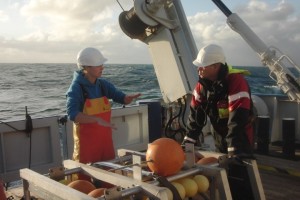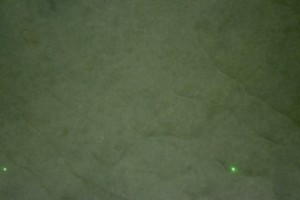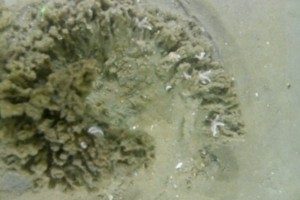Bruce is the name of our camera system designed to film the seafloor. It allows us to directly observe the seafloor and study the distribution of larger animals living on and just above the bottom. We found beautiful tube worm reefs formed by Sabellaria spinulosa!
In the last blog, we explored the sediment using box cores and the SPI camera. With these methods, you study a small area of seafloor in great detail. The opposite is true for acoustic methods in which you study a large area of the seafloor, but with less detail. The acoustic maps show abstract features that are not easily interpreted. For example, it can show an irregularity at the bottom, but you have to make an educated guess about what it could be.
The findings of the above-mentioned methods can be ground-truthed with a camera. By directly observing an area you can study the expected bottom structures, sediment features, and animals living on and just above the seafloor. Is the whole area muddy just as the box core predicted? Or was it a sample of a muddy patch in an area that is mostly sandy? Is the irregularity on the map really a ship wreck, or perhaps a group of large stones?
As proud owners of our camera system Bruce, we took him diving on the Bruine Bank. Bruce has two cameras: a HD video camera for filming, and a photo camera that takes pictures. In all videos and pictures, you can see two laser points. These have a known distance, which later will be used to measure features. Bruce also has eight LED lamps for illumination of the seafloor.
After finding the optimal camera settings during some test runs, we started filming transects at the different box core locations. Each transect is a straight line of 150 meters intersecting with a box core station in the middle. We found that the top of the bank was very sandy, and in the troughs were more shells and stones lying on the bottom.
And we found spectacular life! Striped red mullets (Mullus surmuletus), dragonets (Callionymus sp.), starfish (Asterias rubens), brittle stars (Ophiuroidea), hermit crabs (Pagurus bernhardus), Sabellaria spinulosa reefs and even a small-spotted dogfish (Scyliorhinus canicula) were present. The top of the sand bank seemed poorer in terms of life (figure 4) compared to the deeper troughs (figure 5).
Sabellaria spinulosa is a species of tube worms that form their own tubes by cementing sand (hence the common name sand mason). The reefs are hard 3D structures, providing a complex habitat in an otherwise flat environment. The elevated structures provide shelter for other animals (Figure 6). When an animal creates a new habitat, like the Ross worm, they are called ecosystem engineers. Ecosystem engineers are very important, because they often increase the species richness in an area. The tubes feel quite hard (figure 7), but disintegrate when handled too roughly. Bottom fisheries, which occur regularly at the Brown Bank, may damage these reefs preventing them to grow into even larger structures. Analysis of all collected imagery will hopefully tell us more about the function of these reefs and the impact of human activities on the biodiversity in the area.







